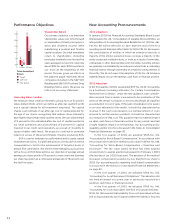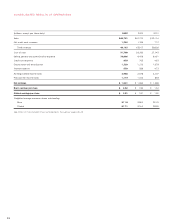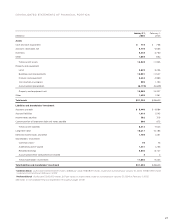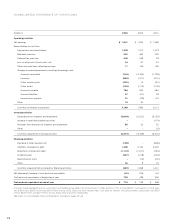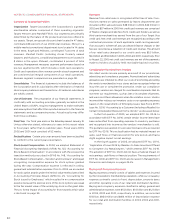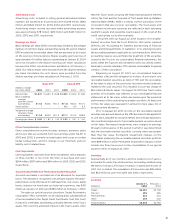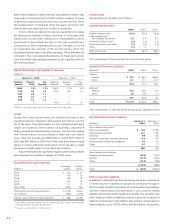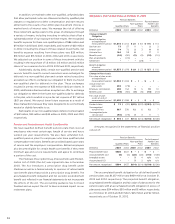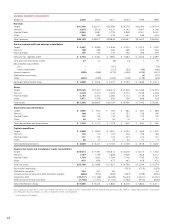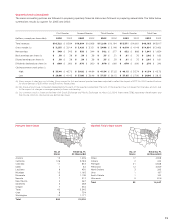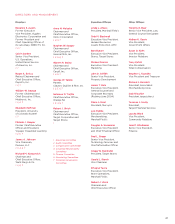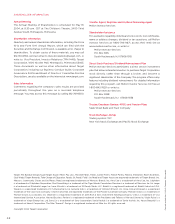Target 2003 Annual Report Download - page 34
Download and view the complete annual report
Please find page 34 of the 2003 Target annual report below. You can navigate through the pages in the report by either clicking on the pages listed below, or by using the keyword search tool below to find specific information within the annual report.
32
Property and Equipment
Property and equipment are recorded at cost, less accumulated
depreciation. Depreciation is computed using the straight-line
method over estimated useful lives. Depreciation expense for the
years 2003, 2002 and 2001 was $1,286 million, $1,183 million and
$1,049 million, respectively. Accelerated depreciation methods are
generally used for income tax purposes. Repair and maintenance
costs were $453 million, $416 million and $386 million in 2003,
2002 and 2001, respectively.
Estimated useful lives by major asset category are as follows:
Asset Life (in years)
Buildings and improvements 8 – 39
Fixtures and equipment 4 – 15
Computer hardware and software 4
We adopted SFAS No. 144, “Accounting for the Impairment
or Disposal of Long-Lived Assets” in the first quarter of 2002. In
accordance with this guidance, all long-lived assets are reviewed
when events or changes in circumstances indicate that the carrying
value of the asset may not be recoverable. The requirements of
SFAS No. 144 are discussed in Management’s Discussion and
Analysis on page 25.
We review most assets at the store level, which is the lowest
level of assets for which there are identifiable cash flows. The
carrying amount of the store assets is compared to the expected
undiscounted future cash flows to be generated by those assets
over the estimated remaining useful life of the primary asset. Cash
flows are projected for each store based upon historical results and
expectations. In cases where the expected future cash flows and
fair value are less than the carrying amount of the assets, those
stores are considered impaired and the assets are written down
to fair value. Fair value is based on appraisals or other reasonable
methods to estimate fair value. Impairment losses are included in
depreciation expense for held and used assets and included within
selling, general and administrative expense on assets classified
as held for sale. Our fixed asset impairment tests, performed in
accordance with the applicable accounting guidance, assumed each
of our segments would continue indefinitely. Changes in these
assumptions could impact the results of our analysis. In both 2003
and 2002, impairment losses resulted in a financial statement
impact of less than $.01 per share.
Goodwill and Intangible Assets
Goodwill and intangible assets are recorded within other long-term
assets at cost less accumulated amortization. Amortization is
computed on intangible assets with definite useful lives using the
straight-line method over estimated useful lives that range from
three to fifteen years. Amortization expense for the years 2003,
2002 and 2001 was $34 million, $29 million and $30 million,
respectively. At January 31, 2004 and February 1, 2003, net good-
will and intangible assets were $364 million and $376 million,
respectively. These assets included $155 million of goodwill and
intangible assets with indefinite useful lives in both years, principally
associated with Marshall Field’s and target.direct.
As required, we adopted SFAS No. 142, “Goodwill and Other
Intangible Assets,” during the first quarter of 2002. In 2003 and
2002, the adoption of this statement reduced annual amortization
expense by approximately $10 million (less than $.01 per share).
The requirements of SFAS No. 142 are discussed in Management’s
Discussion and Analysis on page 25.
Discounted cash flow models were used in determining fair
value for the purposes of the required annual goodwill impairment
analysis. Management used other market data to validate the
results of our analysis. No impairments were recorded in 2003,
2002 and 2001 as a result of the tests performed.
Other Long-term Assets
In addition to goodwill and intangible assets discussed above, the
major components of other long-term assets at January 31, 2004
included pre-funded pension benefits, investments, deferred
financing costs and derivatives. The increase in the long-term asset
balance is primarily due to pre-funded pension contributions of
$200 million partially offset by a $43 million reduction in the value
of derivative assets that were outstanding at year-end. Our pension
plan contributions are disclosed on page 36 and our derivative
transactions are discussed on pages 33-34.
Accounts Payable
Our accounting policy is to reduce accounts payable when checks
to vendors clear the bank from which they were drawn. Out-
standing checks included in accounts payable were $1,325 million
and $1,125 million at year-end 2003 and 2002, respectively.
Lines of Credit
At January 31, 2004, two committed credit agreements totaling
$1.6 billion were in place through a group of 26 banks at specified
rates. There were no balances outstanding at any time during 2003
or 2002 under these agreements.
Commitments and Contingencies
At January 31, 2004, our obligations included notes payable, notes
and debentures of $10,925 million (discussed in detail under Long-
term Debt and Notes Payable on page 33) and the present value
of capital and operating lease obligations of $158 million and $998
million, respectively (discussed in detail under Leases on page 34).
In addition, commitments for the purchase, construction, lease or
remodeling of real estate, facilities and equipment were approxi-
mately $545 million at year-end 2003. Royalty commitments of
approximately $80 million are due during the three-year period
ending in 2007. Throughout the year, we enter into various com-
mitments to purchase inventory. In addition to the accounts payable
reflected in our Statements of Financial Position on page 27, we had
commitments with various vendors for the purchase of inventory
as of January 31, 2004. These purchase commitments are cancelable
by their terms.




